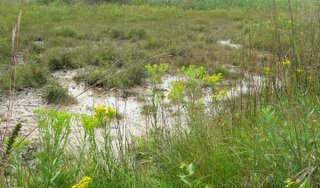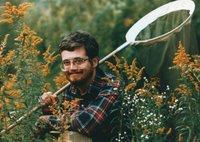I love the desert. The last week in July I did my annual conference/collecting trip in southern Arizona. The conference, sponsored by the
Sonoran Arthropod Studies Institute, is called The Invertebrates in Captivity Conference. It’s IICC for short, but affectionately known as Bugs In Bondage by many of the attendees. It takes place in Rio Rico, just north of Nogales on the Mexican border. It’s partly a typical professional conference with lectures, commercial displays and workshops. This conference also includes lots of fields trips, many with collecting opportunities. Lots of people at the conference collect live critters to bring back to zoos and museums around the country where they will become part of public displays. We also go black lighting to collect nocturnal insects. I’ll probably blog about that in more detail some time- it’s lots of fun.
This year, I attended a field trip to Sycamore Canyon. It’s located very close to Mexico- in fact the canyon terminates at the international border. There are several very interesting ecosystems there and a whole bunch of plant and animal species that just barely make it into the US from Mexico. One of my treasure this year was a little butterfly called the
Cingo Skipperling . It only rarely makes it north of the border, though it’s more common in Mexico. The book
Buterflies of Southeast Arizona describes it as one of the scarcest American species in collections because of its small size and erratic habits. I have two from Sycamore. They were collected a hundred yards and several years apart.
Typically, I go down to Arizona a few days before the conference to knock around Arizona on my own. This year was no exception. I started out by visiting with some
friends in Phoenix. I also took two really nice collecting hikes. One was in the Santa Rita Mountains. I was seeking a species of grasshopper found nowhere else in the world. Alas, it was not to be, though I did collect several specimens of a species, new to me, called
Leprus intermedius. It has
blue wings and is very beautiful. That hike was noteworthy because during my descent, I had an unexpected encounter with a bear. No biologists were harmed during the encounter.
My other hike was to French Joe Canyon. It’s a beautiful spot in the Whetstone Mountains southeast of Tucson. I have always felt that calling this spot a canyon is a bit of a stretch. Most of the hike is along an arroyo through the desert. At the end, the trail winds up into a small valley in the Whetstones. But I love the spot. The scenery is absoloutely beautiful and the collecting unparalleled. The two main species that I go to see there are
Gyascutus caelata and
Dendrobias mandibularis. They are both beautiful beetles. Gyascutus are two inches long, bullet shaped, and a metallic dark purple-green with yellow markings. Underneath, they have lots of metallic purple. They adults eat pollen out of the acacia flowers that grow along the trail. They fly with an alarmingly loud buzzing sound, probably mimetic of carpenter bees.
Dendrobias are longhorned beetles with beautiful yellow and black markings. I find them feeding on sap flows on the stems of desert broom bushes.
One of my favorite parts of going to the desert is exemplified by French Joe Canyon. As you hike in, the noise of vehicles on the highway diminishes as you venture deeper and deeper into the wilds of the desert. Human evidence diminsihes to a minimum, and one is left with the opportunity to wander alone with ones thoughts to observe and enjoy the bounty of life that can be found there. The silence can be profound, with noise reduced to the crunch of your boots on the trail, the wind in your ears, and the occasional punctuation of the call of a bird or the buzz of a beetle or a grasshopper. It’s a place to reconnect and re-center. Returning there always feels like going home to me.
Labels: Collecting, Travel










